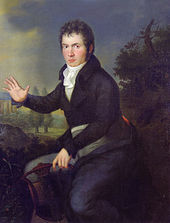Piano Sonata No. 21 (Beethoven)
The piano sonata No. 21 (op. 53) "Waldstein" is a three-movement sonata by Ludwig van Beethoven . It is dedicated to the friend and sponsor Count Waldstein . Beethoven sketched it in December 1803, just before he began working on the opera Fidelio . In August 1804 he offered them to the Leipzig publisher Breitkopf & Härtel with the sonatas op. 54 and op. 57 . Strictly in the sonata form , crystal clear in tone and structure, the first and third movements are full of orchestral sound. More than all other Beethoven sonatas, the Waldstein sonata has the characteristics of a piano concerto without an orchestra.
construction
- 1st movement: Allegro con brio, C major, 4/4 time, 302 bars
- 2nd movement: Introduzione, Adagio molto, F major, 6/8 time, 28 bars
- 3rd movement: Rondo, Allegretto moderato, C major, 2/4 bar, 543 bars
1 sentence
The theme, introduced by a knocking C major triad with eighth notes in the bass range and followed by an "echo" in the treble , builds up the great tension and dynamism of the movement. With sixteenth - octaves instead of entrance-eighth the theme is repeated. Via a figurative B major passage, it finds its way to the calm secondary theme in the main mediante in E major , dolce e molto legato . After the repeated exposure , the execution begins in the subdominant F major . The whimsical play with the initial motif is followed by extensive modulation from C major via F major, B major, E flat minor, F sharp major, B minor and C minor to the dominant G major. The broken triplet chords anticipate the 2nd movement. The dominant recipes between bass and treble are concentrated in one measure to the recapitulation in the tonic , from fortissimo to pianissimo . The second half of the eight bars turns into a gloomy D minor , which is immediately softened by the full-bar fermatas on A-flat and B-flat, comes up again and, via the swelling E major, finds the orchestral secondary theme in A major . The knocking opening motif returns once more in D flat major , followed by a simple cadence and dolce, the secondary theme in the tonic.
2nd movement
Beethoven originally planned a middle movement. Since his tone of voice did not quite match the corner movements and endangered the balance of the sonata before the long final movement, Beethoven published it as a separate Andante favori (WoO 57); formally, however, the introduction of the 2nd movement comes close to the sonata form . After the symphonic 1st movement it is the “stopping point” of the sonata. In F major , the subdominant of the radiant C major, and kept quiet throughout, it is a "subdued play of colors of loosened chord figures". The rhythm and the thirty-second notes in the bass at the end give an idea of what follows. After the turn into the dominant G major , Attacca subito follows the rondo .
3rd movement
A concertante movement begins, which can easily be placed next to the 1st movement of the 4th piano concerto according to its tone and length . The crossed left hand plays the song , while the right hand gives the inner swing. The pedal holds the organ points C and G and carries through the relaxed play with tonic and dominant seventh chord . The theme develops over trills his right hand while the left scales in demisemiquavers has to deal with. This development of themes is followed by a defiant, looked-up secondary theme in the parallel key of A minor with sixteenth-note triplets in the bass. The uproar of the C minor intermediate section - broken sixteenth notes on the right and pedaled root notes on the left - comes to rest in double octaves of the theme. After the repetition of the two-part opening, the rondo theme ends in the cadenza with non-stop sixteenth-note triplets in both hands. Prestissimo in the Allabreve , but the coda begins softly and easily . With its octaves and polyphonic trills, it also presents virtuosos with very high hurdles.
literature
- Joachim Kaiser : Beethoven's 32 piano sonatas and their interpreters . Frankfurt am Main: S. Fischer 1975. ISBN 978-3-100-38601-4
- Siegfried Mauser : Beethoven's piano sonatas. A musical work guide , Munich: Beck 2nd edition 2008. ISBN 978-3-406-57572-3
- Kurt Dorfmüller, Norbert Gertsch and Julia Ronge (eds.): Ludwig van Beethoven. Thematic-bibliographical catalog of works . Munich: Henle 2014, Volume 1. pp. 288–292
Individual evidence
- ^ Otto Emil Schumann : Handbook of Piano Music , 4th edition. Wilhelmshaven 1979
Web links
- Waldstein Sonata in the digital archive of the Beethoven House in Bonn
- Piano Sonata No. 21 (Beethoven) : Sheet music and audio files in the International Music Score Library Project


